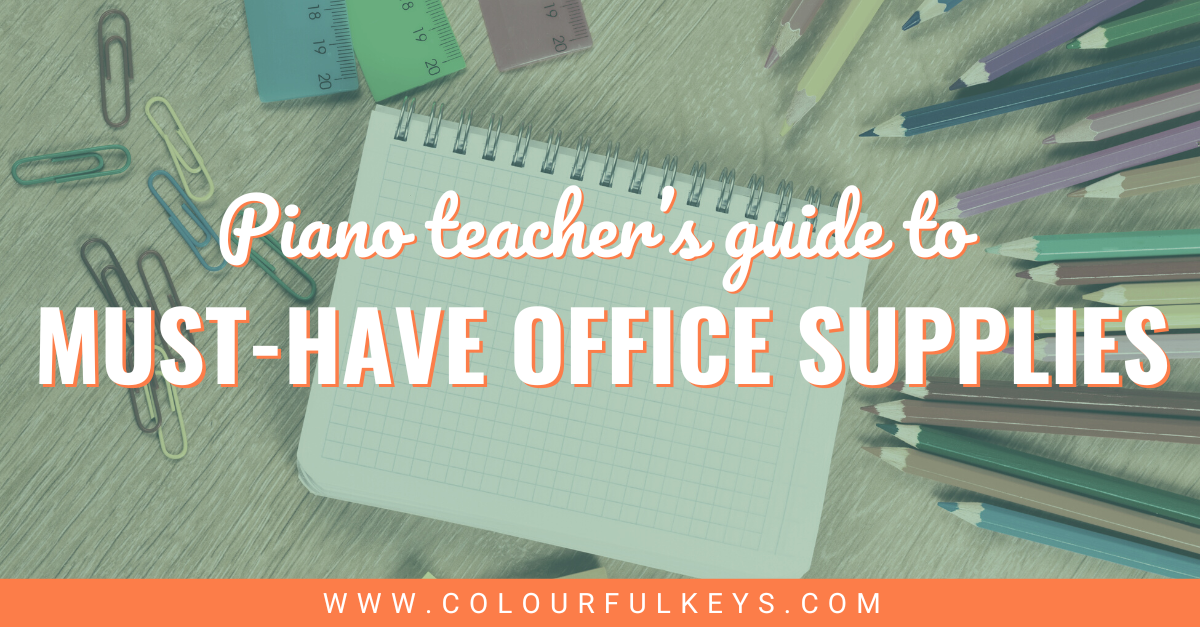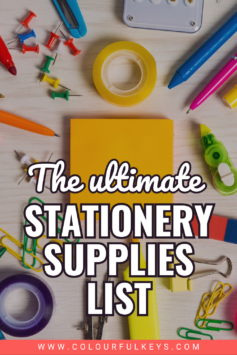
This blog post about office supplies for your piano studio was written by Joanna Shiel. Joanna works on the editorial team for Vibrant Music Teaching. She’s been teaching for nearly 15 years, both in-person and online. In her spare time, Joanna loves hiking, spending time in nature and discovering new places to eat.
OK. We ALL love stationery, right? That’s why we became teachers! Alright, of course I’m joking, but getting the right office supplies in your piano studio can make life a lot easier.

Now, I’m not talking about supplies for students. I’m referring to the things that are going to enhance your teaching life – those bits and bobs that bring a little more peace and tranquillity to your working life. And isn’t that what we all want?
Whether you love to organise everything digitally or go completely analogue, here are some tried-and-trues that I love to use in my studio (plus one or two items that might surprise you 🤫).
Things to Write With
You probably have a really special instrument for teaching, so why not have really special writing instruments?
A Really Good Pen and Pencil
There’s nothing worse than reaching for a pen and it’s either dry, scratchy or, God forbid, doesn’t exist.
When you’re teaching, you’re most definitely writing. It could be directly on your students’ music, in their practice diary, on post-it notes or wherever there’s a random, blank bit of paper. If you just have one or two pieces of kit, invest in quality writing utensils. Then do your level best to keep them in a handy and safe place.
Multi-Coloured Pens
I love to use a variety of coloured pens and highlighters with my younger students. Colour can be a great visual reminder when:
- Helping students identify notes for left hand vs right hand
- Showing how notes go up or down
- Marking longer notes so students can see how they take up more space in the music
- Identifying 2nds and 3rds, ala the Piano Safari method
Even if you only have a few key colours like blue and red, it will make your teaching life so much easier to have colourful writing implements at the ready.
Pro tip: If you’re hesitant to write in your students’ music with anything other than a pencil, try Pilot’s Frixion line of pens, markers, and highlighters. They really do erase well!
Things to Write On
Those carefully chosen writing utensils will go to waste if you don’t have places to use them. Make sure you have the following items to hand in your studio.
White Board
A grand staff whiteboard is one of my most essential pieces of kit. Here are some of the ways I use this piece of stationery:
- Note drawing practice
- Quick compositions
- Pitch recognition
- Drawing and examining a rhythm
- Writing out scales
- Tracking scores during a game or activity

If you don’t own a grand staff whiteboard, you can create your own using a laminator and a printer. Here’s how:
- Print a blank staff and keyboard onto cardstock. (Leave one side blank for non-staff teaching.)
- Laminate it.
Boom! Instant vital teaching tool. 🤘 Just don’t forget to purchase dry erase markers for writing on your DIY whiteboard.
A Notebook
A journal, planner or notebook will help you keep reminders or capture to-dos during lessons. But beyond the day-to-day chaos management of your planner, you may want to have a notebook to hand that you can jot in quickly, get your thoughts out, then digest your scribbles when your teaching day is less frantic.
My planner doubles as a piano teaching journal to keep notes on how my teaching went, whether a game worked particularly well or anything I want to remember about my teaching life.
Pro tip: Look for a notebook with a hard cover so it’s not flopping around on your lap while you’re trying to write and watch your student at the same time. Alternatively, use a clipboard with loose paper that you put into a binder later.
Sticky Notes
I find it useful to have different shapes and sizes of sticky notes and sticky flags available at all times. They’re so versatile! With sticky notes, you can:
- Create on-the-go lesson plans
- Mark sections for interleaved practice sessions
- Make a visual map for students who are neurodivergent or who need an outline of the lesson schedule
- Give students “free choice” by writing down lesson activities on several separate sticky notes and allow them to arrange how they’d like to tackle them
- Remind yourself of games you’d like to lend particular students by attaching the note to their assignment sheets or studio folders
- Test memorisation by blocking out a couple of bars of music with sticky notes
The possibilities truly are endless when it comes to using sticky notes!
Speaking of sticky…
Sticky Stuff
Around the Colourful Keys blog, we like to talk about how to make learning “stick”. But no studio stationery kit is complete without some “sticky” stuff, too.
Blue Tack
I always make sure to stock up on this handy product every year. Blue tack (aka sticky tacky or adhesive putty) isn’t just for sticking posters on the wall. It’s also helpful for keeping flash cards or paper on the piano keys.
You can even use it to create makeshift counters for Vibrant Music Teaching games.
Stickers
This may be a controversial take, but stickers can be a cheap, fun and timeless way to celebrate a job well done if used judiciously. I have yet to meet a child (or adult) who doesn’t love a sticker.
Much like sticky notes and colourful highlighters, stickers can also be used in lots of ways:
- Mark sections of students’ pieces
- Draw their eyes to tricky spots
- Use matching stickers to make connections between repeat markings such as D.S. or codas
- Motivate, track progress or mark off studio challenges (check out the stickers in the Colourful Keys Store)
- Give reminders about which technique to use, such as Piano Safari’s animal techniques

If used judiciously, stickers can be a useful addition to the office supplies in your piano studio.
And last but absolutely not least…
Laminator & Pouches
This was a bit of an investment for my studio, and I wasn’t sure whether I’d use it. However, my laminator has now become a necessary part of my teaching stationery kit.
Whether you’re keen to make Nicola’s VMT Games Library a physical reality or just want to keep posters clean and dry, laminating is quick, easy and fun.
Pro tip: Since laminating sheets aren’t especially eco-friendly, choose wisely when deciding whether to laminate something. For example, I like to laminate the cards in my teaching games but not the game boards, covers, or instructions.

What are your can’t-live-without piano studio office essentials?
Let me know in the comments below. Then hop over to “organisation central” at Nicola’s hub page devoted to all-things-business.
You can use your newly-acquired laminator and blu-tac to create Solfa Hand Sign posters for all your ear-training needs. Enter your info below and Nicola will send you the posters for free.

Subscribe to updates and get the CURWEN HAND SIGN POSTERS
Enter your details to subscribe to the newsletter for piano teachers with information, tips and offers.
I hate spam as much as you do! I’ll only send you information that’s directly relevant to music teachers and you can unsubscribe at any time.
If you’re a member of Vibrant Music Teaching, you can download the hand sign posters instantly from the Printable Library. Not a member? You’re missing out on so much! Learn more and join today at vibrantmusicteaching.com.